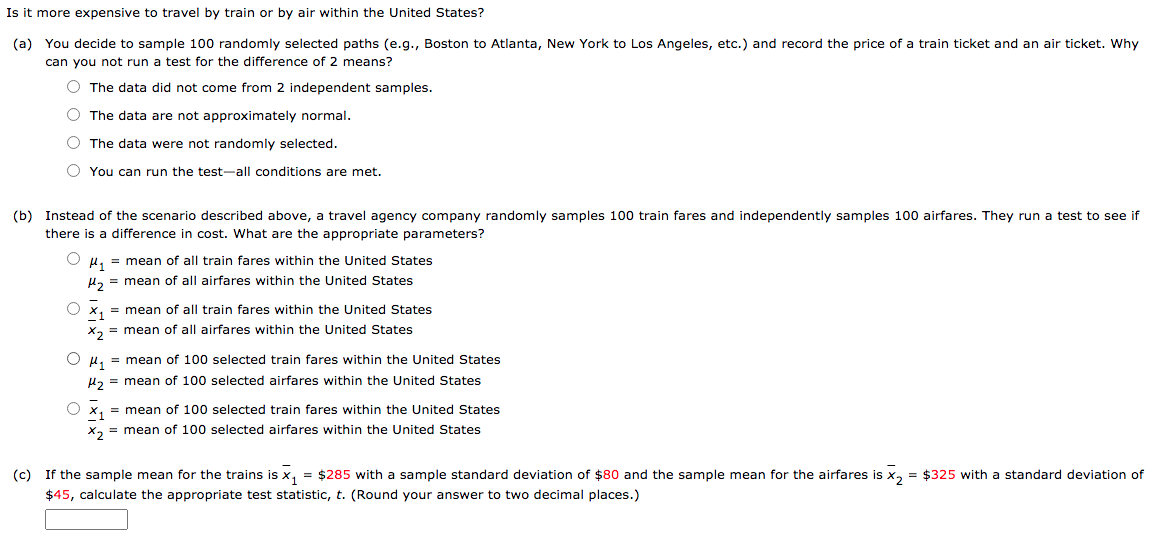Is it more expensive to travel by train or by air within the United States? (a) You decide to sample 100 randomly selected paths (e.g., Boston to Atlanta, New York to Los Angeles, etc.) and record the price of a train ticket and an air ticket. Why can you not run a test for the difference of 2 means? O The data did not come from 2 independent samples. O The data are not approximately normal. O The data were not randomly selected. O You can run the test-all conditions are met. (b) Instead of the scenario described above, a travel agency company randomly samples 100 train fares and independently samples 100 airfares. They run a test to see if there is a difference in cost. What are the appropriate parameters? O u, = mean of all train fares within the United States H, = mean of all airfares within the United States O x, = mean of all train fares within the United States X, = mean of all airfares within the United States u, = mean of 100 selected train fares within the United States H, = mean of 100 selected airfares within the United States = mean of 100 selected train fares within the United States X, = mean of 100 selected airfares within the United States (c) If the sample mean for the trains is x, = $285 with a sample standard deviation of $80 and the sample mean for the airfares is x, = $325 with a standard deviation of $45, calculate the appropriate test statistic, t. (Round your answer to two decimal places.)
Is it more expensive to travel by train or by air within the United States? (a) You decide to sample 100 randomly selected paths (e.g., Boston to Atlanta, New York to Los Angeles, etc.) and record the price of a train ticket and an air ticket. Why can you not run a test for the difference of 2 means? O The data did not come from 2 independent samples. O The data are not approximately normal. O The data were not randomly selected. O You can run the test-all conditions are met. (b) Instead of the scenario described above, a travel agency company randomly samples 100 train fares and independently samples 100 airfares. They run a test to see if there is a difference in cost. What are the appropriate parameters? O u, = mean of all train fares within the United States H, = mean of all airfares within the United States O x, = mean of all train fares within the United States X, = mean of all airfares within the United States u, = mean of 100 selected train fares within the United States H, = mean of 100 selected airfares within the United States = mean of 100 selected train fares within the United States X, = mean of 100 selected airfares within the United States (c) If the sample mean for the trains is x, = $285 with a sample standard deviation of $80 and the sample mean for the airfares is x, = $325 with a standard deviation of $45, calculate the appropriate test statistic, t. (Round your answer to two decimal places.)
Chapter9: Sequences, Probability And Counting Theory
Section9.7: Probability
Problem 4SE: What is the difference between events and outcomes? Give an example of both using the sample space...
Related questions
Topic Video
Question

Transcribed Image Text:Is it more expensive to travel by train or by air within the United States?
(a) You decide to sample 100 randomly selected paths (e.g., Boston to Atlanta, New York to Los Angeles, etc.) and record the price of a train ticket and an air ticket. Why
can you not run a test for the difference of 2 means?
O The data did not come from 2 independent samples.
O The data are not approximately normal.
O The data were not randomly selected.
O You can run the test-all conditions are met.
(b) Instead of the scenario described above, a travel agency company randomly samples 100 train fares and independently samples 100 airfares. They run a test to see if
there is a difference in cost. What are the appropriate parameters?
O µ, = mean of all train fares within the United States
u, = mean of all airfares within the United States
O x, = mean of all train fares within the United States
X, = mean of all airfares within the United States
O H, = mean of 100 selected train fares within the United States
µz = mean of 100 selected airfares within the United States
O x, = mean of 100 selected train fares within the United States
X, = mean of 100 selected airfares within the United States
(c) If the sample mean for the trains is x, = $285 with a sample standard deviation of $80 and the sample mean for the airfares is x, = $325 with a standard deviation of
$45, calculate the appropriate test statistic, t. (Round your answer to two decimal places.)
Expert Solution
This question has been solved!
Explore an expertly crafted, step-by-step solution for a thorough understanding of key concepts.
This is a popular solution!
Trending now
This is a popular solution!
Step by step
Solved in 3 steps

Knowledge Booster
Learn more about
Need a deep-dive on the concept behind this application? Look no further. Learn more about this topic, statistics and related others by exploring similar questions and additional content below.Recommended textbooks for you


Glencoe Algebra 1, Student Edition, 9780079039897…
Algebra
ISBN:
9780079039897
Author:
Carter
Publisher:
McGraw Hill

College Algebra (MindTap Course List)
Algebra
ISBN:
9781305652231
Author:
R. David Gustafson, Jeff Hughes
Publisher:
Cengage Learning


Glencoe Algebra 1, Student Edition, 9780079039897…
Algebra
ISBN:
9780079039897
Author:
Carter
Publisher:
McGraw Hill

College Algebra (MindTap Course List)
Algebra
ISBN:
9781305652231
Author:
R. David Gustafson, Jeff Hughes
Publisher:
Cengage Learning